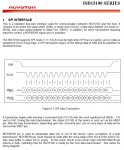Hi All,
I would like to use a 20X2 chip to control a voice record and playback chip, specifically an ISD15100 via SPI. Being a novice with communications I was hoping for some clarity before I delve into detail.
As I understand it, when I send a command byte to the ISD15100, during the transmission the status of the ISD is returned via the MISO pin (each command bit on the MOSI line triggers a bit on the MISO line representing status of different parameters). Will the built in SPI functions of the 20X2 allow me to read this chip status while also sending?
The ISD chip also states it uses SPI mode 3 but I can't figure out how this applies to the HSPISETUP mode variable.
Any help is greatly apprectiated.
I would like to use a 20X2 chip to control a voice record and playback chip, specifically an ISD15100 via SPI. Being a novice with communications I was hoping for some clarity before I delve into detail.
As I understand it, when I send a command byte to the ISD15100, during the transmission the status of the ISD is returned via the MISO pin (each command bit on the MOSI line triggers a bit on the MISO line representing status of different parameters). Will the built in SPI functions of the 20X2 allow me to read this chip status while also sending?
The ISD chip also states it uses SPI mode 3 but I can't figure out how this applies to the HSPISETUP mode variable.
Any help is greatly apprectiated.
Last edited:

